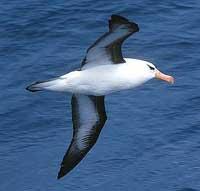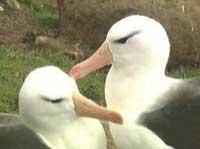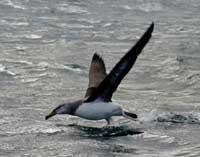Albatrosa, a guide for scientists
The albatross seems to have two faces; when it is on the ground it is a clumsy animal, but when flying and passing over the sea it offers a unique and beautiful spectacle. It is the largest bird flying with 2-3 meters in length. Therefore, it is not surprising that the interest of researchers is limited to the fishing route of the bird mainly.

The latest research on Albatros flights comes from an article published in the journal Science of 15 February. The research was conducted by researchers from the Chizé biological research centre (CNRS), under the direction of Henri Weimerskirch. Crozet has been proposed in the Crozet archipelago, located between Madagascar and Antarctica, and has used cutting-edge materials in microelectronics and computing to analyze the attitude of marine hunters without leaving their surroundings.
Cutting-edge technology
The Albatrosses are not only great flyers and hunters, but also prudent. And thank you! In reproductive times, both male and female travel more than 150,000 km from the feeding nest to the fishery. Of course, this causes them enormous fatigue, but air currents reduce energy consumption to the maximum.
This hypothesis was already known, but it was not confirmed. Energy expenditure was measured using the same device used by athletes to measure heart rate. In addition, they were placed a chip that sent information by GPS to determine the position of each bird with a frequency of 1-5 seconds. The researchers placed the chip on the back of a fortnight of albatrosses and not having traps on the ground, all the devices have worked smoothly during the investigation. In total, with a hundred grams of technology they have managed to know
in detail the fishing and energy consumption of the albatross.
Valuable research results
In order to analyze the variations in energy consumption, the relationship between beat frequency and energy consumption was previously defined in the laboratory. The study has shown that this consumption depends on several factors. On the one hand, there is movement and activity, that is, if the bird is on the ground or is flying. On the other hand, there are environmental parameters such as sea temperature, direction and wind strength.
When the bird is flying and takes advantage of the air current in the area, energy consumption decreases considerably (roughly the same as when the man is at rest), but this does not reduce the speed. Upside down, with wind in favor, Albatrosa is able to reach 135 km/h!

On the contrary, when flying against the wind, energy consumption increases and speed decreases considerably. However, the
greatest energy consumption occurs in landing and flight.
It takes years for the Albatros to fully master this navigation technique and
reduce energy consumption to the maximum. Fortunately, they have a long survival (some individuals studied are around 50 years old) and adults improve the transmission of knowledge throughout life.
After the reproductive period, the albatrosses, each for its part, head to the sea. Yes, before it separates, each couple dances love to know each other at the age of two. Meanwhile, with enough work, they head to the sea to spend the sabbatical year. Before concluding this research, for biologists it was the mystery that was made in that sabbatical year.
A sabbatical year at sea
To continue bird movements for a whole year, researchers have used small geolocation systems. These electronic devices record
the light intensity and temperature every minute and their memory is more than two years.

At the end of the sabbatical year, the albatrosses return to Croz, when the time comes to recover and analyze what was recorded. Using algorithms, the information received by the devices becomes the flight path.
The light intensity allows to identify the time of entry and exit of the sun, which determines whether the bird has moved to the east or to the west. From the time of sunrise the length is measured. Latitude is calculated by the length of the day. These data show that every albatrosses come every two years to a certain place where the whole sabbatical year passes.
Like many other seabirds, the great albatross is about to disappear by human activities. Thanks to the monitoring carried out over the last forty years, researchers have complete information on the demographics of the albatross population. This will allow us to understand the decrease in the number of birds and determine the relationship between human fishing campaigns and albatross flights.
Published in the supplement Estación de Gara.
Buletina
Bidali zure helbide elektronikoa eta jaso asteroko buletina zure sarrera-ontzian











